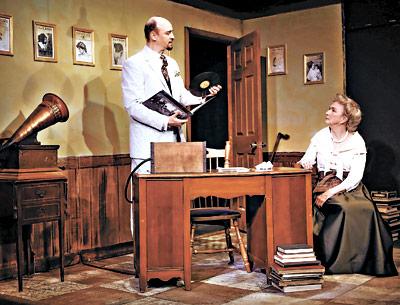Historic Figures Brought to Life

“Dr. Du Bois and Miss Ovington,” a new play by Clare Coss now showing in New York at the Castillo Theater, thrusts its audience into the 1915 struggle within the National Association for the Advancement of Colored People: Should the N.A.A.C.P. be a philanthropic organization run by whites for the betterment of blacks, or should it be run by blacks with white support?
This two-character play gives us the creative genius of the black W.E.B. Du Bois, played by Tim Simonson, and a white socialist champion of racial equality (as well as women’s rights), Mary White Ovington, played by Kathleen Chalfant. The two give fine performances that provide insight into these historic figures, but the play does not get below the skin.
It must be pointed out that this is a showcase production, that is, a production designed to explore the potential and possible directions the play can go. It runs slightly under an hour and a half, with no intermission, and remains a work in progress.
The play opens with Du Bois giving a lecture at Oberlin College, using slides to illustrate the racism blacks face, while Ovington speaks on the same subject to a church audience. Then they get together and start to tussle.
We are in the New York office of the fledgling N.A.A.C.P. A drumbeat for war in Europe is pounding outside on Fifth Avenue. In what is perhaps the strongest element of the play’s well-rendered set, designed by Chris Cumberbatch, a map on an office wall is dotted with pins marking locations of lynchings around the country; they are concentrated in the Deep South.
As editor of “The Crisis,” the N.A.A.C.P.’s journal, Du Bois is demanding that the white board of directors give him autonomy. Mr. Simonson offers what is apparently an exact likeness of Du Bois, in both manner and speech. He has a letter of resignation tucked in his jacket pocket, which he repeatedly threatens to hand in.
Ms. Chalfant, who is wonderful in the role of Ovington, believes in Du Bois and thinks he is essentially right, but, at the same time, believes he must compromise on occasion. Both actors seemed a bit ill-at-ease at the top of the show, where the playwright has them locking horns. It was only during a quiet moment, when Du Bois sings along with a recording, that the actors seemed truly connected to the material and each other, drawing in the audience, and this reviewer.
The lead into that moment was problematic. Du Bois goes to his office, pulls the record out of its sleeve, and calls in Ovington. Mr. Simonson has drawn the exterior of the character very well, but the way this occurs is mechanical. You are in the heat of an argument, you have left the room, you see a record, you pick it up — and stop. A pause, in which the actor conveys what Du Bois may be thinking — asking himself what the music and Ovington mean to him — is missing. It is the kind of effect the director, Gabrielle L. Kurlander, needs to catch.
There are other uneven moments, where the director’s intentions are unclear. For example, when Ms. Chalfant uses a period telephone on Ovington’s desk, she shouts. When Mr. Simonson uses it as Du Bois, he doesn’t.
The play is, however, at its best when it is quiet. The two spar, then flirt, then spar again. When it gets noisy, when they battle about political points, it slides, without intending to, into agitprop. Ms. Coss faithfully gives the audience a lot of information. What is missing is the soul.
The historic Du Bois is rich and fascinating, and filled with inner conflicts. For example, he is a pacifist, yet wants black soldiers to lead the way and excel if the nation goes to war. In this play, he moves through these conflicts a little too easily.
“Why don’t you take your jacket off, in this heat?” Ovington asks at one point. “I’m used to being uncomfortable,” Du Bois answers. It’s funny, but I wish we could have gotten a little deeper into that inner conflict.
Perhaps Ms. Coss’s adherence to a realistic setting and arc for the piece is the problem. With a little less realism and a little more magic, we might approach the pith of these two complicated souls. Nevertheless, all involved should be complimented for bringing history to life.
The play will run through Feb. 16. Tickets are $25, $20 for students and senior citizens.
